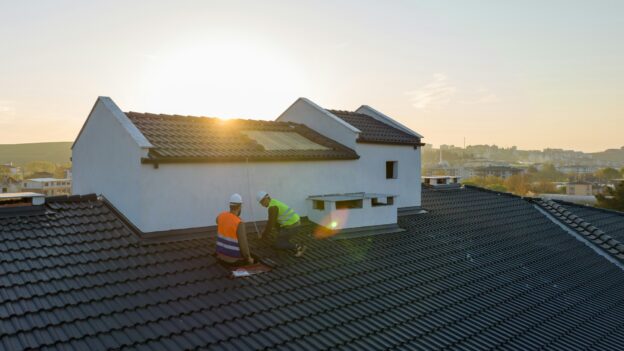Roofs are one of the most important parts of a house. They protect us from the weather and keep the home safe. But like anything else, they need care too. Regular roof inspections can help find small problems before they become big, expensive ones.
Many people only think about their roof when there is a problem, like a leak or damaged shingles. By then, the damage might already be costly to fix. Regular inspections help spot issues early, making repairs cheaper and easier.
Ignoring roof maintenance can lead to bigger problems later. From water leaks to mold, small issues can snowball into major repairs. Keeping the roof in good shape also helps save on energy bills and can even boost the value of your home. Investing in regular inspections pays off in the long run.
The Importance of Regular Roof Inspections
Roof inspections are necessary to keep your home in good shape and prevent small problems from becoming big headaches. Regular checks help spot issues early, like missing shingles, leaks, or blocked gutters. These simple findings during an inspection can save tons of money and hassle in the future.
Common issues found during inspections include damaged shingles, water leaks, and mold. Inspectors often find broken or curled shingles, which can let water into the house. Water leaks can lead to mold and mildew, damaging the ceilings and walls. Inspecting the roof also catches problems with the structural integrity of the roof, helping to ensure it stays strong and safe.
Ignoring roof maintenance can cause long-term damage. Small leaks can rot wooden beams, making the roof weak. If the gutters are clogged, water can pool and damage the roof and walls. Regular inspections help avoid these problems, keeping the roof and home in good condition.
Financial Benefits of Regular Roof Inspections
Preventing costly repairs is one big benefit of regular roof inspections. Finding small problems early makes fixing them easier and cheaper. This helps avoid major repairs that cost much more. For example, fixing a few missing shingles is cheaper than repairing a large water-damaged area.
Regular inspections also extend the roof’s lifespan. When issues are fixed right away, the roof stays in better shape for longer. This means you won’t need to replace it as often, saving you lots of money.
Lowering energy bills is another perk of roof inspections. Making sure there are no gaps or leaks helps keep your home warm in winter and cool in summer. This reduces the strain on heating and cooling systems, cutting down energy costs.
Lastly, regular roof inspections can increase your property’s value. A well-maintained roof makes the house more attractive to buyers. They see it as one less thing to worry about, making your home more appealing and worth more. A good roof inspection record can even speed up the selling process.
Invest in regular roof inspections to save money and keep your home in top shape.
Common Problems Detected During Inspections
During a roof inspection, many common problems can arise. It’s crucial to identify these issues early to prevent them from getting worse. Here are a few typical problems that can be detected:
1. Damaged Shingles or Tiles: One of the most common issues inspectors find is damaged shingles or tiles. They can be cracked, missing, or curled. These damaged areas can let water seep in, leading to leaks and further damage.
2. Water Leaks and Mold Growth: Water leaks are another frequent problem found during inspections. If left unchecked, water can cause mold to grow inside your home. Mold can harm your health and damage the building’s structure.
3. Structural Issues: Over time, the roof’s structure can weaken. Inspectors often find problems like sagging, broken beams, or rotted wood. These issues need to be fixed right away to avoid a total roof failure.
4. Gutter and Drainage Problems: Clogged or damaged gutters can cause water to back up and damage the roof. During inspections, gutters are checked to ensure they are clear and properly directing water away from the house.
How to Schedule Regular Roof Inspections
Scheduling regular roof inspections is simple, and doing so can save you a lot of trouble and money. Here’s what you need to know:
1. Best Times of Year for Inspections: The ideal times to schedule roof inspections are spring and fall. This allows you to check for damage after winter storms and prepare for the rainy season. Regular checks before and after severe weather ensure the roof stays in good shape.
2. What to Expect During an Inspection: During an inspection, a roofing professional will carefully examine your roof. They’ll check for damaged shingles, leaks, and structural issues. They’ll also inspect gutters and drainage systems. The goal is to identify any problems and recommend solutions.
3. Choosing a Reputable Roofing Contractor: It’s important to hire a reputable roofing contractor for your inspections. Look for contractors with good reviews and proper certifications. A trusted contractor will ensure a thorough inspection and provide honest advice on any repairs needed.
Conclusion
Regular roof inspections are essential for keeping your home safe and sound. They help identify problems early, saving you the cost and stress of major repairs down the road. From damaged shingles to water leaks, knowing what to look for and when to inspect can make a big difference. By extending the roof’s lifespan, reducing energy bills, and even increasing property value, regular inspections are a wise investment.
Living in a well-maintained home gives peace of mind. It also ensures that your family stays safe and comfortable. Investing in regular roof inspections not only protects your house but also helps you save money over time. Whether it’s spring or fall, schedule your next roof inspection to catch any issues before they turn into costly repairs.
If you’re looking for a reliable roofing partner, contact Sutter Roofing’s roofing contractors in Sonoma County today to schedule your inspection. We’re here to help you keep your home in the best condition possible.








